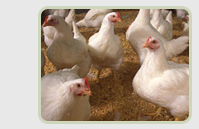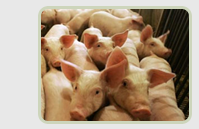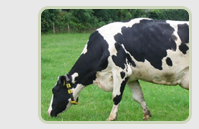FULL-FAT SOY-BEAN
ADVANTAGES OF FULL-FAT EXTRUDED SOY-BEAN
High nutrition value and great amount of protein in extruded full-fat soy-bean (table 1) make it a very important component for inclusion into rations of animals and birds.
1. STO – thermally treated soy-bean
2. PES – extruded full-fat soy-bean
High nutrition value of full-fat extruded soy-bean is composed of the following factors determined by processes passing during extrusion:
- break of fat cells walls that increases availability of digestive enzymes to oil;
- high digestibility of oil;
- high content of non-saturated fat acids.
Use of extrusion allows to obtain a fodder (table 2) with high nutrition value (4224 kcal/kg for a bird), with high level of nitrogen digestion (84 %) at high quality of protein – red cresol tests is 4,2 mg/g (the red cresol tests is used for indirect determination of heating level for soy-bean products). Value of 3,7 - 4,3 mg/g characterizes soy-bean as “well-boiled”).
Fat digestibility during extrusion reaches 80 % that is almost for two times higher than fat digestibility of soy-bean oil cakes (45 %).
Nutrition value of full-fat extruded soy-bean is close to maximally possible value.
Content of raw protein in full-fat extruded soy-bean is the same as in raw soy beans – 38 %. Extrusion increases digestibility of proteins, makes amino acids more available due to damage of secondary connections in protein molecules. Due to relatively law temperatures and short time of thermal treatment the amino acids are not damaged during this treatment.
High nutrition value and great amount of protein in extruded full-fat soy-bean (table 2) make it a very important component for inclusion into rations of animals and birds.
Amount of protein which does not decompose in rumen in increased in the process of extrusion which is very important for ruminant animals. Full-fat soy-bean is an excellent source of essential amino acids, excluding methionine.
Doctor Macnab (Poultry Research Center in Edinburg, Great Britain) established that besides high level of energy value, the full-fat soy-bean processed in extruders is characterized by high digestibility of amino acids that exceeds digestibility obtained by other methods of thermal treatment of soy-beans (table 3).
Digestibility of lysine and sum of amino acids for different methods of soy-bean processing.
In this way full-fat extruded soy-bean processed on extruders:
- is a high-caloric fodder with high content of protein that is universal for all types of animals and birds;
- protein digestibility is the same as for soy-bean oil cake - over 90%;
- is characterized by high digestibility of oil, in particular of fat acids required for reduction of thermal stress;
- contains great amount of tocopherol that provides oil stability during storage. Lipoxidase and lipase are damaged;
- is characterized by high content of main fat acids – linolic and linolenoic acids – 9.0 and 2.0 respectively;
- has a high content of lecithin (important for fat metabolism) - 0,7%;
- has great taste properties.
This provides its main technological properties, in particular:
- resistivity to long-term storage (up to 6 months);
- easiness of oil adding to ration. There is no need in special tanks for oil storage and dosing devices for oil adding to combined fodders;
- great looseness;
- great ability to granulating (comparing with other components containing oil additives);
- minimal losses of nutritive components in the process of processing and lack of dust in final fodder product.
Table 1. Composition of soy-bean products
Substance
Soy-bean oil cake
44%
48%
STO1
PES2
Dry matter, %
89,0
90,0
90,0
93,0
Protein, %
44,0
48,5
37,0
38,0
EE of birds, kcal/kg
2230
2440
3300
4020
EE of pigs, kcal/kg
3220
3385
3625
4180
EE of lactation, Mcal/kg
1,73
1,81
1,96
2,28
Extrusion
0,8
1,0
18,0
18,0
Acid hydrolysis
-
-
-
19,5
Fiber, %
7,3
3,9
5,5
5,2
Calcium, %
0,29
0,27
0,25
0,25
Phosphorous, %
0,65
0,62
0,58
0,60
Available phosphorous, %
0,29
0,24
0,25
0,25
Sulphur, %
0,33
0,33
0,22
0,22
Amino acids, %
-
-
-
-
Methionine
0,65
0,72
0,51
0,54
Methionine + cystine
1,34
1,45
1,15
1,10
Lysin
2,93
3,18
2,40
2,40
Triptophane
0,62
0,67
0,55
0,59
Threonine
1,81
1,91
1,50
1,52
Isoleucine
2,39
2,57
2,00
1,72
1. STO – thermally treated soy-bean
2. PES – extruded full-fat soy-bean
High nutrition value of full-fat extruded soy-bean is composed of the following factors determined by processes passing during extrusion:
- break of fat cells walls that increases availability of digestive enzymes to oil;
- high digestibility of oil;
- high content of non-saturated fat acids.
Use of extrusion allows to obtain a fodder (table 2) with high nutrition value (4224 kcal/kg for a bird), with high level of nitrogen digestion (84 %) at high quality of protein – red cresol tests is 4,2 mg/g (the red cresol tests is used for indirect determination of heating level for soy-bean products). Value of 3,7 - 4,3 mg/g characterizes soy-bean as “well-boiled”).
Fat digestibility during extrusion reaches 80 % that is almost for two times higher than fat digestibility of soy-bean oil cakes (45 %).
Nutrition value of full-fat extruded soy-bean is close to maximally possible value.
Content of raw protein in full-fat extruded soy-bean is the same as in raw soy beans – 38 %. Extrusion increases digestibility of proteins, makes amino acids more available due to damage of secondary connections in protein molecules. Due to relatively law temperatures and short time of thermal treatment the amino acids are not damaged during this treatment.
High nutrition value and great amount of protein in extruded full-fat soy-bean (table 2) make it a very important component for inclusion into rations of animals and birds.
Table 2. Energy value of soy-bean derived products
Technologies
Energy value for birds, kcal/kg
Nitrogen digestion, %
Red cresol tests, mg/g
Wet extrusion
4270
56
4,60
Dry extrusion
4224
84
4,20
Fine grinding
3773
66
4,47
Roasting
3716
67
4,20
Jet fruits
3403
63
4,45
Raw beans
3231
30
2,50
Soy-bean oil cakes + oil
4169
60
4,25
Amount of protein which does not decompose in rumen in increased in the process of extrusion which is very important for ruminant animals. Full-fat soy-bean is an excellent source of essential amino acids, excluding methionine.
Doctor Macnab (Poultry Research Center in Edinburg, Great Britain) established that besides high level of energy value, the full-fat soy-bean processed in extruders is characterized by high digestibility of amino acids that exceeds digestibility obtained by other methods of thermal treatment of soy-beans (table 3).
Digestibility of lysine and sum of amino acids for different methods of soy-bean processing.
Table 3. Digestibility depending on types of thermal treatment of soy-bean
Type of thermal treatment
Digestibility, %
Of lysin
Of sum of amino acids
Extrusion
90,6
92,5
Wet extrusion
84,8
85,6
Micronization (after wetting)
86,1
87,9
Micronization
89,0
90,4
Continuous roasting
89,3
87,9
Roasting
90,6
91,4
Soy-bean oil cake
91,7
92,0
In this way full-fat extruded soy-bean processed on extruders:
- is a high-caloric fodder with high content of protein that is universal for all types of animals and birds;
- protein digestibility is the same as for soy-bean oil cake - over 90%;
- is characterized by high digestibility of oil, in particular of fat acids required for reduction of thermal stress;
- contains great amount of tocopherol that provides oil stability during storage. Lipoxidase and lipase are damaged;
- is characterized by high content of main fat acids – linolic and linolenoic acids – 9.0 and 2.0 respectively;
- has a high content of lecithin (important for fat metabolism) - 0,7%;
- has great taste properties.
This provides its main technological properties, in particular:
- resistivity to long-term storage (up to 6 months);
- easiness of oil adding to ration. There is no need in special tanks for oil storage and dosing devices for oil adding to combined fodders;
- great looseness;
- great ability to granulating (comparing with other components containing oil additives);
- minimal losses of nutritive components in the process of processing and lack of dust in final fodder product.



 Level of full-fat soy-bean during fattening depends on type of fodder. In Europe amount of full-fat soy-bean is usually reduced to maximum 5 % three weeks before butchering of pigs. Otherwise level of soy-bean is determined by economical considerations and as a rule is up to 30 % excluding initial stage of young animals fattening when the level is 5 – 10 % because of high sensitivity of the young animals to inhibitor of trypsin.
Level of full-fat soy-bean during fattening depends on type of fodder. In Europe amount of full-fat soy-bean is usually reduced to maximum 5 % three weeks before butchering of pigs. Otherwise level of soy-bean is determined by economical considerations and as a rule is up to 30 % excluding initial stage of young animals fattening when the level is 5 – 10 % because of high sensitivity of the young animals to inhibitor of trypsin.

